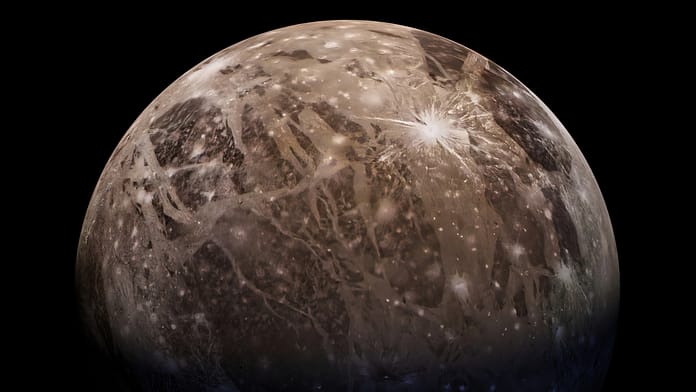
A computer-generated representation of Jupiter’s moon Ganymede. (Graphic: Shutterstock.com)
Researchers have detected water vapor in the atmosphere of Jupiter’s largest moon, Ganymede. As evidence, scientists point to measurement data that was recorded as early as 1998, but then interpreted differently.
Scientists have been searching for Ganymede’s surface for decades. Only now, however, have researchers been able to use images from the Hubble telescope to prove the presence of water vapor in the thin atmosphere of Jupiter’s moon. The basis for the discovery is ultraviolet images taken in 1998. They had streaks similar to those of the northern lights on Earth. The researchers explained the recordings at the time with atomic oxygen in the atmosphere. When the measurements were made in 2018, almost no atomic oxygen could be found in the atmosphere. So there must be another reason.
Researchers at the Royal Technical University of Stockholm now have I found a possible explanation. The scientists compared the different distribution of bands on images from 1998, 2010 and 2018. Their interpretation: The surface temperature of the icy moon Ganymede sometimes changes dramatically throughout the day. According to scientists, around noon it can warm up at the equator so that the ice there directly changes to a gaseous state and enters the atmosphere as water vapor. The differences in the images confirm the theory, as they relate to where the water should be in the moon’s atmosphere.
Soon, Issa takes a closer look at Ganymede
NASA’s Jupiter probe didn’t capture high-resolution images of Ganymede until June 2021. Next year, another Esa spacecraft, the Juice probe, will blast off to Jupiter. This probe is expected to reach its destination in 2029 and then examine Ganymede and two other moons of the planet in addition to Jupiter. The juicing assignment should last at least three years.
Lorenz Roth, who discovered with his colleagues, hopes that “our results can provide juice instrument teams with valuable information they can use to improve their monitoring plans in order to better use the spacecraft,” who and his colleagues discovered water vapor in Ganymede’s atmosphere. .
